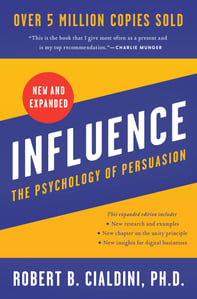Share article
We talk about books a lot, referencing them as part of our philosophies, our curriculum, and through our coaching. We thought it would be fun to let you in on some of the books that make an impact on our internal work at Q4i and the work we do with our clients.
Welcome to the Q4i Book Report! The book we'll be talking about is Influence: The Psychology of Persuasion by Robert Cialdini, Ph.D.
 About the author
About the author
Dr. Cialdini is an expert in the science of influence and how to apply it ethically in business. His Six Principles of Persuasion has become a cornerstone for many organizations and individuals looking to effectively increase their influence.
Why I read it
I have always believed that to lead effectively, one must be able to influence others effectively.
What is the premise?
It breaks down the psychology of what makes people agreeable and shows how to apply these principles in everyday situations.
Who should read it?
Anyone wanting to understand the psychology of selling and buying should read this book. It is just as relevant for someone on the receiving end (buyer) of attempts to influence as it is for those looking to be the influencer.
Ideas from the book I’ve referenced most often
At times, I felt the book might be more appropriately titled "Manipulation." Many of the examples the author uses are smarmy sales techniques that give salespeople a bad name. However, I found it fascinating to hear about the studies he referenced to demonstrate how hard-wired we are psychologically to respond to specific influences.
It is also important to remember, any powerful idea can be used for good or bad. All that aside, I found the six principles addressed in the book to be extremely valuable as we look to influence others and understand our responses.
Reciprocation – (As described in the book) The internal pull to repay what another person has provided us.
Once someone has done us a favor or given us something, we mentally feel indebted and driven to return the favor somehow.
Where you have experienced this –Those free samples at the grocery store aren't simply to sample the product; they create an indebtedness that drives many to make a purchase.
How you might use this ETHICALLY (I’m emphasizing this aspect of the principles quite intentionally) – Give freely, without expectation, of your ideas and advice. Those who benefit from what you have given them will be much more inclined to turn to you for the implementation and application of those ideas.
Scarcity – (As described in the book) We want more of what is less available or dwindling in availability.
It’s natural to want what you think you can’t have. Items and opportunities have more perceived value as they become less available.
Where you have experienced this – Every Christmas, there seems to be the "hot toy.” The harder it is to find, the more attention it creates, and demand increases even more. This is quite an intentional phenomenon.
How you might use this ethically – Host webinars or seminars with attendee interaction at the end. To ensure everyone can participate, limit the number of seats.
Authority – (As described in the book) We are more likely to say “yes” and believe those we perceive as an authority.
Three of the most common signs of authority are title, dress, and cars. According to the book, we rarely question someone with a title, such as “Doctor” (Dr.). People at a crosswalk are much more likely to follow a well-dressed co-walker against the light. We even find more patience for drivers of expensive cars who don’t take off when the light turns green.
Where you have experienced this – “I’m not a doctor, but I play one on TV.” This ad for cough syrup is a blatant use of the Authority principle. You know this isn't a doctor. They even tell you they aren't a doctor. However, they still benefit from the title we associate with their television character.
How you might use this ethically – Establish yourself as an authority figure by regularly speaking at conferences, writing blogs, and getting yourself quoted by news outlets.
Commitment and Consistency – (As described in the book) Once we choose or take a stand, we work to behave consistently with that commitment to justify our decisions.
In the book, three control groups estimated the lengths of lines. The first group wrote down their guesses and shared them publicly. The second wrote down their guess but didn't share them. The third only thought about their guesses.
When presented with evidence that their estimations were wrong, the first group rarely changed their answer. The third group changed answers readily, and the second group was in between.
The more public we are with a commitment, the less likely we are to settle for less.
Where you have experienced this – If you have ever participated in a survey or signed a petition, you may have felt significantly more committed to the position after sharing and/or confirming that commitment.
How you might use this ethically – When meeting with a prospect, establish, at the very beginning of the sales process, what they hope to accomplish. You could even suggest a target. Ask them, "If we identify an opportunity for meaningful improvement to your overall HR/benefits program and can demonstrate our ability to address any such needs, could you see us moving forward in a working relationship?"
By establishing this as the initial target and then confirming their commitment to it during the sales conversation, they become much more likely to move forward to such a goal.
Liking – (As described in the book) The propensity to agree with people we like and, just as important, the tendency for others to agree with us if we like them.
If we admire, find attractive, have something in common, or enjoy someone else, they will much more easily influence us.
Where you have experienced this – Attractive models in ads.
How you might use this ethically – Dress professionally. Be a genuine and vulnerable person; let others know you and see what is likable about you. Be generous with sincere and heartfelt compliments.
Social proof – (As described in the book) When we are unsure, we look to others “like us” to provide us with the correct actions to take.
And the more people we see taking action, the more we consider that action to be proper. Plus, the more the people are "like us," the more potent their social influence.
Where you have experienced this – Look no further than any website utilizing 5-star ratings and customer testimonials.
How you might use this ethically – There is no reason to re-invent the wheel on this one. Allow your clients to rate your impact on them through ratings and testimonials.
My biggest takeaway
I have long said nobody wants to be sold to, but we all like to make better buying decisions. As I look at these principles, they all can be used in a very negative way. They also have the potential to lead to better decisions.
Because the principles address very real aspects of how we're hard-wired to make decisions, they provide great insight into how to better connect with your audience.
Just be genuine and well-intended as you follow them.
Here’s my take on the principles.
- Give freely without expectation.
- Identify what each prospect and client wants/needs to accomplish. Ideally, get this in writing.
- Ask clients to comment on the positive impact you have made.
- Be likable. Of course, not everyone will like you. But give those people who appreciate who you are the chance to know and enjoy the real you.
- Establish yourself as an authority at what you do for your clients.
- Take a respectful position that it is a privilege to work with you, and the privilege can't be made available to just anyone.
Recommendation
Influence: The Psychology of Persuasion is worth the read. However, I recommend you focus as much on what not to do as you focus on what to do. But remember, those are usually opposite sides of the same coin. ⭐⭐⭐⭐
Content provided by Q4intelligence and partners
Photo by Sebnem Ragiboglu.
